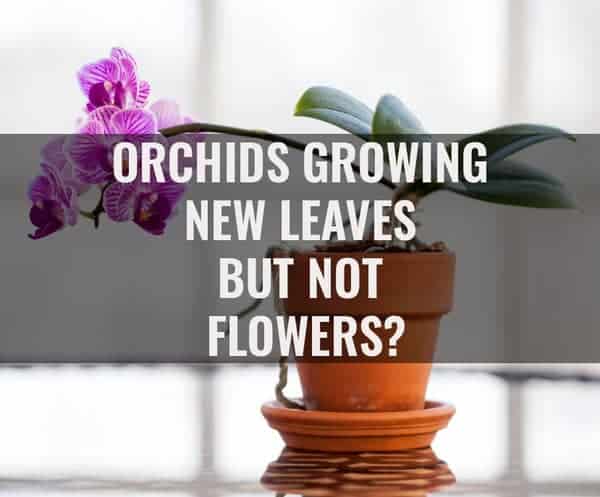Orchids are one of the most popular houseplants. These are delicate and exotic plants with stunning foliage. They are good for room decor and spread peaceful vibes; they are popular as stress-relieving plants.
But it happens that orchids do not bloom for a long time. There are many reasons for orchids growing new leaves but not flowers. Some of these are wrong placement, improper care, or wrong season.
This article focuses on all the reasons why your orchids may not be blooming. It also includes simple tips to induce flowering in your indoor orchid plants.
Contents
Why Are My Orchids Not Blooming?
Low Sunlight
Orchids thrive in bright sunlight. The amount of the sun reaching their foliage triggers them to bloom. They never bloom in low sunlight. So if your orchids are growing new leaves but not flowers, it means they need more sunlight exposure.
To make sure low sunlight is the real culprit, take a look at your plants’ foliage. If they are droopy, it is another sign that your orchids are asking for more light. It would be best if you moved it to a brighter spot in your home to induce flowering.
One thing to keep in mind here is that orchids do not appreciate direct sunlight. Direct sunlight burns their leaves, so you should keep them under indirect or diffused sunlight.
An east or south-facing window is perfect for the placement of orchid plants. Your plant will receive plenty of light to produce new flowers in these spots.
Low Temperature
Orchids love to grow in warmer environments. Most orchid species bloom in summers when the temperature is relatively high. The ideal temperature for orchids to bloom is 75°F.
The temperature should be checked regularly for the orchids growing new leaves but not flowers. If the temperature is below 75°F, these exotic plants should be kept in a greenhouse or terrarium for a while. These modified environments will keep the plants warm and trigger them to produce flowers.
Some orchids bloom in winters. They can bloom in temperatures as low as 50°F. So there is no need to keep these plants in the terrarium during summers because they are not going to bloom anyway.
Improper Potting Mix
Orchids are a bit fussy when it comes to their growing medium. They require a proper potting mix to grow. If you plant your orchids in the wrong substrate, they may not bloom at all.
So if your orchids are not producing flowers and you have ruled out all other reasons, you need to repot them. Repotting the orchids into suitable potting soil will surely help the plants produce beautiful flowers.
You can buy the special orchid mix from the market for your orchid plants. But if you want to prepare potting mix on your own in your home, we are here to help you.
Here are the main ingredients that you will need to prepare the best potting mix for your orchids.
- Peat moss contains sand.
- Sphagnum moss
- Oak or bark chips
- Coconut husk
- Agroperlite
Mix one part of these ingredients to prepare a well-draining and porous potting mix for your orchids.
Root Problems
Sometimes the reason for your orchids growing no flowers is poor root development. It can also be due to root rot. Healthy roots are one key element needed for flower production.
Orchids are highly sensitive to overwatering. If you overwater your orchids, they will develop root rot. No orchid can produce flowers when dying at its root level from root rot. It is why you should water orchids only when their topsoil is dry. It will prevent root rot problems.
Moreover, you should re-pot your orchids every year or two to observe their roots. If there are any damaged roots, you should remove them while repotting.
Wrong Season
Every orchid follows a different blooming schedule. Orchids bloom after their growth stops in spring—some bloom in summer, some in fall, and most in winters. So the wrong season could be a reason for your orchids growing new leaves but not flowers. You just have to be patient with your plants and wait for its blooming season.
Almost all orchids come with plant labels when you buy them. You can track when your orchids will bloom by reading these labels because they mention the correct blooming time for those plants.
What to Do if My Orchids Are Not Blooming?
You have to create the ideal growing conditions for your orchids to bloom indoors. Orchids are high-maintenance plants, so they will give you a tough time managing their care routine. To provide your plants with the best growing conditions, follow these instructions.
- Keep your orchids 5 feet away from a south-facing window or in the windowsill of an east-facing window.
- Use a fast-draining and porous potting mix for their pots.
- Fertilize them once every other week with balanced liquid fertilizer.
- Keep them in a warm room where the temperature stays between 50°F and 75°F.
- Water them once every week.
- Keep them in transparent pots so you can monitor their root growth.
Conclusion
The most common reason for orchids growing new leaves but no flowers is insufficient sunlight. Other possible causes are low temperature, improper potting mix, root problems, and wrong season. If your orchid is not blooming, look closely at the signs it is giving you. It can be dry leaves, droopy foliage, reduced growth, or mushy roots. These signs will help you pinpoint the main reason why your orchids are not growing flowers.

